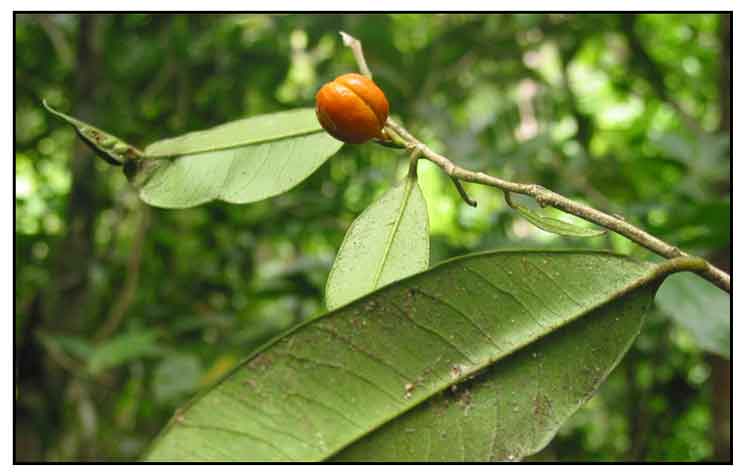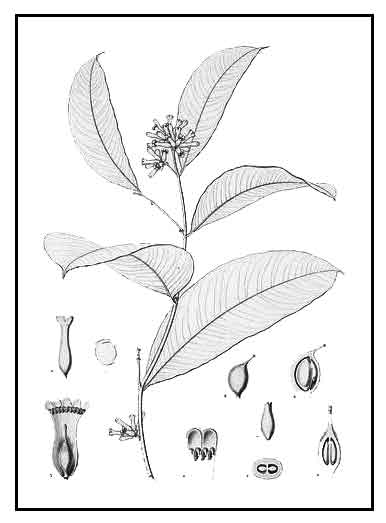|
 Gen info Gen info
- Agarwood refers to an occasional product of a few genera of Aquilaria and Gyrinops in the plant family Thymelaeaceae.
-
Agarwood is the most expensive wood in the world, an occasional product of a few genera of Aquilaria and Gyrinops in the Thymelaeaceae family. Agar is a scented product, oleoresin, from the wood of live trees. The quality of agar depends on the plant species and fungal species involved, together with still unknown factors. (2)
- The heartwood is light and pale colored; but, as the wood matures, the tree produces a dark aromatic resin in response to infection or unknown induction, which results in a very dense, dark resin-embedded heartwood.
(2)
- There are 15 species of Aquilaria in the world but only 8 produce resin in response to fungal attacks. (11)
- Healthy Aquilaria tree does not produce agarwood. Healthy wood is white, soft, even grained, without a perfumed smell, compared to the dark, hard, and heavy scented resin-impregnated agarwood. Agarwood resin develops through pathological, wounding and non-pathological mechanisms. Formation of agarwood occurs naturally in response to natural injuries such as lightning, insects, and mold attacks. The deposited resin around the wounds accumulate over years and eventually forms agarwood. In essence, agarwood is resin-impregnated pieces of wood, formed as a defense mechanism of Aquilaria trees in response to biotic and abiotic stresses. (19)
- In theory, agarwood can be produced by all members; however, until recently it was primary produced from A. malaccensis, A. agallocha, and A. secundaria.
(2)
- Three species are reportedly found in the Philippines: Aquillaria apiculina, A. acuminata, and A. cumingiana.
(2) Another list includes five species as present in the Philippines: Aquilaria apiculata Merr., a. citrinicarpa (Elmer) Hallier f., A. malaccensis Lam., A. parviflora (Quisumb) Ding Hon, and A. urdanetensis (Elmer) Hallier f.
-In Japan, agarwood is called jinko. There are several grades, the highest of which is known as kyara. Â (2)
- Trees grow very fast, flowering and producing seeds as early as four years old. (2)
- Agarwood is exported in various forms viz. wood chips, powder, oil, end products like perfumes, incense and medicines. Agarwood is exported in various forms viz. wood chips, powder, oil, end products like perfumes, incense and medicines.
- First-grade agarwood is one of the most expensive natural raw materials in the world. In 2010, the price for superior pure material was as high as $100,000 / kg.
- The expensive price comes from low yield from plant material, labor intensive extraction processes. Low grade resinous wood used for oil production require a minimum of 20 kg to produce 12 ml of oil. (11)
• Commercially available agarwood is derived from fungus-infected trees through wounds caused by species of Aspergillus, Fusarium, Penicillium, and Fungi imperfecti.
- "Qi-Nan" is regarded as the highest quality agarwood, with its mysterious oriental odor that can be smelt without burning, unlike other kinds of agarwood. (14)
• Because of inflated demands and rapidly declining population of Aquilaria species in the wild, the yields of agarwood collected from the wild is shrinking, as the price continues to rise, restricting scientific research and wide application. (14)
• All species of Aquilaria have been places on the Appendix II list of the Convention on International Trade in Endangered Species of Wild Fauna and Flora since 2004. (14)
Botany
Palisan is a shrub or small tree,
growing to a height of 5 meters. Bark is ashy gray, mottled, and
smooth. Leaves are alternate, smooth, elliptically oblong, about 15
centimeters long and 4-6 centimeters wide at the largest, with pointed tip and a blunt or
rounded base. Flowers are yellowish, about 1.5 centimeters long, borne in fairly
small, rounded clusters. Fruit is pendant and orange-red, containing
a single seed and two locules across which it splits upon opening, slightly
obovoid or broadly ellipsoid and about 1.5 centimeters long. Seeds are ovoidly
compressed, about 7.5 millimeters long.
Distribution
- Native to the Philippines.
-
Found in primary forests at
low and medium altitudes in Nueva Ecija, Bulacan, Quezon, Laguna, Camarines, and Albay Provinces in Luzon; and in Catanduanes, Samar, Sibuyan, Leyte, Panay, Mindanao, and Jolo.
- Also native to Borneo and Maluku.
- Classified as "vulnerable" in the IUCN Red List of Threatened Species.
(7)
Constituents
- The species is considered a source of agarwood.
- Agarwood is the resinous hardwood that is formed in Aquilaria and Gyrinop trees when they are invaded by mold.
- The production of resinous compounds is associated with wounding by insects that probably assist fungal invasion. (3)
- Chemical constituents of agarwood originating from the genus Aquilaria include
2-(2-phenylethyl)-4H-chromen-4-one derivatives and sesquiterpenes, the two predominant constituents, along with terpenoids, flavonoids, etc. There have been 154 new compounds isolated from agarwood and the genus Aquilaria trees. In total, 88 new 2-(2-phenylethyl)chromone compounds have been isolated from agarwood and the genes Aquilaria. (14)
 Properties. Properties.
- Considered hemostatic, carminative, heart stimulant, and tonic.
Parts used
Bark, wood, fruit
Uses
Folkloric
• In the Philippines, bark and roots
are applied to wounds to stop bleeding. Bark, wood and fruit used as substitute for quinine.
• In Malaysia, agarwood used to treat jaundice and body pains. Also used as tonic during pregnancy and after childbirth. (2)
• Incense from wood considered aphrodisiac, carminative and sedative. Used in the treatment of cancer, especially of the thyroid gland; also for treatment of asthma and abdominal complaints such as colic and diarrhea, (5)
• In India, agarwood has been used as carminative, antiasthmatic, anti-diarrhea, antidysenteric; used in gout, rheumatism, paralysis, and as stimulant in sexual debility. (Dr. Devang J Pandya) (13)
- In traditional Chinese medicine, agarwood is used as a
qi-regulating drug and carminative to relieve gastric problems, rheumatism, and high fever. (14)
Others
• Rituals: Incense and essential oil used in Buddhist, Hindu and Confucian ceremonies. (5) (6)
• Essential oil: Essential oil from heartwood used in oriental perfumery. (5) (6)
• Bark / Wood: Used for making paper, ropes and cloth. Wood used for wood carving and for light indoor construction, veneer, and making boxes. (5) (6)
• Agarwood: In wood 15-20 years old or older, deposits of dark brown, aromatic resin may develop in the vascular tissue. Wood patterned with this resin constitute the valuable agar wood. Since antiquity, wood has been burned in religious rituals and as incense sticks to release the fragrance. (9)
 Info on Agarwood Info on Agarwood
• Agarwood / Agar / Oleoresin: Agarwood is a dark resinous heartwood that forms in Aquilaria and Gyrinops trees in the family Thymelaeaceae. There are 17 species of Aquilaria known to produce agarwood. The best known among them are A. agollocha, a. malaccensis, and A. crassna. Agarwood-producing Aquilaria species found in the Philippines are A. apicultina (Mindanao), A. acuminata, A. cumingiana, and A. filarial. A dark aromatic resin is produced in response to induction/infection. The yield of agar, an oleoresin, is dependent on the plant species and the infection/induction involved. Ascomycetous mold, Phaeoacremonium parasitica, a dermatiaceous fungus has been identified as one of the known fungi associated with agarwood formation.
(2) (3)
• Used of Agarwood: Agarwood is highly valued by luxury perfume, fragrance, and soap manufacturers. Agarwood fragrances are used in soaps and shampoos. It is also used in traditional medicine to relieve pain, asthma, and nausea. In Malaysia, agarwood is mixed with coconut oil as liniment, and used as decoction for rheumatism and other body pains. Pure agarwood is used as incense. (2)
• Agarwood and its essential oil: Agarwood and its essential oil are in the cultural and religious records of ancient civilizations, mentioned in ancient texts of the Sanskrit Vedas from India, third century AD in ancient China, and seventh century Harshacharita. Agarwood use in perfumery goes back several thousand years, the use of the bark for writing material still continues in Assam, and continues to be used in many traditional pharmacopoeias, especially in ayurvediic, Tibetan, and traditional East Asian medicine. (2)
• Extraction Methods: Agarwood oil is distilled through hydrodistillation, steam distillation, and supercritical CO2 extraction. Older trees have higher resin content. First distillation is reported to yield the best quality oil. (11)
Studies
• DNA Barcoding: Study reports on a DNA barcoding technique to generate barcode sequences for Aquilaria species for application in the identification of sources of agarwood in the market.
• Search yielded no reports on Philippine cultivation of Aquilaria species for agarwood. Barcoding has the potential of contributing to international timber trade control through a method of species identification and product identification. (10)
•
Phytoconstituent Compounds / Pharmacological Activity: No phytochemical or pharmacological studies have been done specifically on A. cumingiana. Chemical constituents of agarwood originating from the genus Aquilaria include
2-(2-phenylethyl)-4H-chromen-4-one derivatives and sesquiterpenes, the two predominant constituents, along with terpenoids, flavonoids, etc. There have been 154 new compounds isolated from agarwood and the genus Aquilaria trees. In total, 88 new 2-(2-phenylethyl)chromone compounds have been isolated from agarwood and the genes Aquilaria. This study (Shuai Wang et al.) reports on the phytochemical constituents and the pharmacological activity of fraction and components from agarwood and Aquilaria trees, in particular, studies on A. sinensis, which showed laxative effect, antmicrobial activity, anti-inflammatory, neuropharmactocoligal activities among many others. (14)
•
Fiber Morphology and Extractive Content: Based on morphological properties, A cumingiana fibers are favorable for pulp and paper production, which will minimize wood wastes and maximize utilization. Paper from fibers tend to be less resistant to tear. The color lightness is a good indicator for extractive content of agarwood and its quality. The darker the color of the wood the higher the extractive content, indicating potentially higher quality agarwood. (15)
Availability
- Wild-crafted.
- Exported from source countries as wood chips, powder, essential oil,, or as finished products.
|



